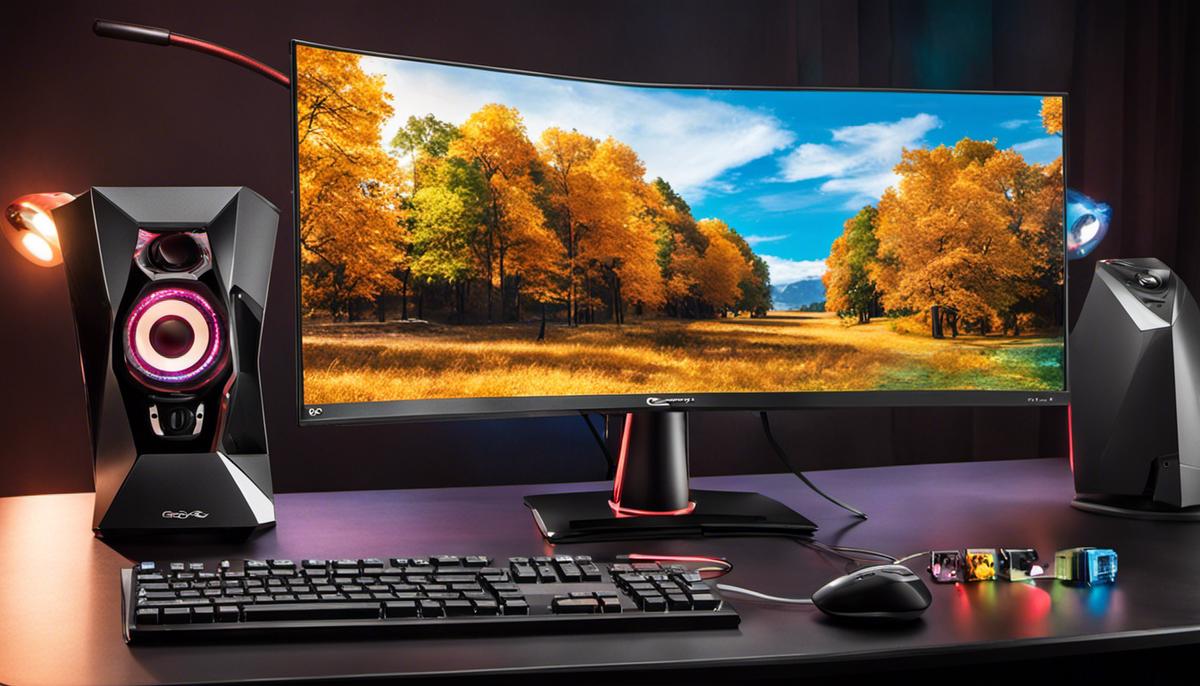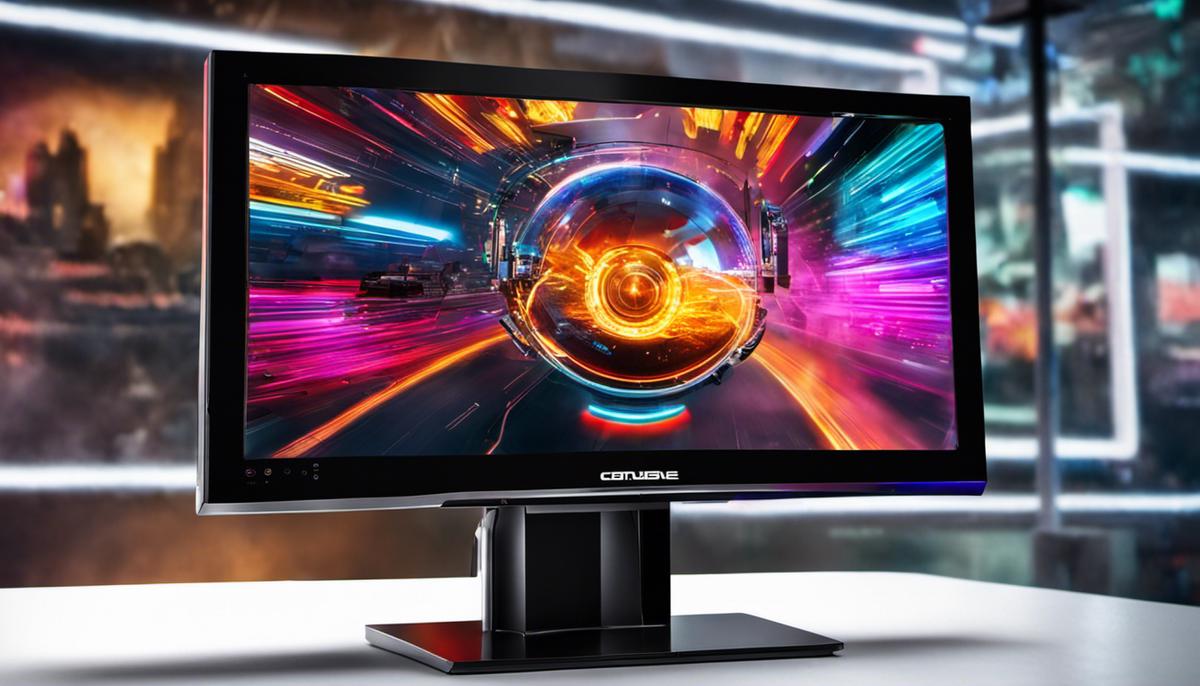Immersing yourself in the captivating universe of video gaming is no shallow affair. Whether you’re a casual player or an esports professional, the quality of your gaming monitor plays a critical role in creating an enriching and seamless gaming experience. This article will delve deeper into understanding the intricate dynamics of gaming monitor specifications, such as refresh rates, response times, and resolutions. Furthermore, a comparative analysis of the top-rated gaming monitors on the market today will be undertaken, bearing in mind the differing needs and preferences of various gamers. The delicate balance between price and performance will also be explored, challenging popular narratives and offering pragmatic insights to gamers. Finally, we’ll turn our gaze towards the horizon, where we’ll anticipate future trends in gaming monitor technology and consider how these could shape the landscape of digital gaming.
Table of Contents
Understanding Gaming Monitor Specifications
Every gaming enthusiast understands the crucial role a monitor plays in the entire gaming experience. Selecting the best gaming monitor, however, requires a solid understanding of key specification criteria. This is where rationality and a keen eye for detail become vital. Let’s succinctly delve into the various factors that could influence your decision-making process when it comes to choosing the ideal gaming monitor.
One of the most critical aspects to consider is resolution. Gaming monitors come in several resolutions: 1080p (Full HD), 1440p (2K), and 2160p (4K), each offering a different gaming experience. The rule of thumb here is straightforward; the higher the resolution, the sharper the images. However, this comes with the necessity of a highly powerful graphics card to handle rendering higher-resolution games smoothly.
Next in line is the refresh rate. Measured in Hertz (Hz), this defines the number of times the monitor can update with new information per second and directly impacts how smoothly motion is rendered. Common refresh rates are 60 Hz, 144 Hz, and 240 Hz. Avid gamers should lean towards monitors with higher refresh rates, significantly reducing image ghosting and providing an incredible fluidity of motion.
Almost as critical is the response time, indicative of the time taken (in milliseconds) for a pixel to change from black to white or between different shades of gray. Lower response times result in lesser motion blur and are generally preferred. Competitive gaming requires monitors with response times as low as 1ms.
Panel type is another key determinant. There are primarily three types of panels – TN (Twisted Nematic), VA (Vertical Alignment), and IPS (In-plane Switching), each with its strengths and weaknesses. TN panels offer the lowest response times, VA panels excel in color reproduction and contrast situations, while IPS panels are a balance between the two but excel in color accuracy and viewing angles.
Adaptive sync technology also plays a crucial part in reducing tearing and stuttering issues that arise due to the dissonance in the refresh rate of the monitor and the frame rate of the graphics card. Two types are notable here – G-Sync (Nvidia) and FreeSync (AMD). Ensure your choice aligns with your graphics card for optimal performance.
Lastly, the aspect ratio determines the width and height of the gaming monitor. Classic monitors come with a 16:9 aspect ratio, but wider formats like 21:9 and 32:9 have grown in popularity, providing a broader field of view.
In essence, the best gaming monitor would need to hit the sweet spot in resolution, refresh rate, response time, panel type, adaptive sync technology, and aspect ratio, in line with your individual gaming needs and the specifications of your machine. Admittedly, this may involve striking a delicate balance between performance and budget, but making an informed decision will significantly enhance your gaming experience. Happy gaming!

Top Gaming Monitors in the Current Market
Digging into Gaming Monitors: Notable Standouts in Today’s Market
With a firm grasp on the key features that make up an incredible gaming monitor, it’s time to delve into the best options in the current market. Top-rated brands have been battling it out for the attention of gamers worldwide, pushing the boundaries of technology to produce phenomenal offerings. Here are some of the standout gaming monitors that have caught the community’s attention due to their performance and innovative features.
- Alienware AW3420DW: Known for its premium gaming equipment, Alienware does not disappoint with this model. The standout feature is its impressive 34-inch 1440p curved display with an ultrawide 21:9 aspect ratio, providing immersive gaming experience. The IPS panel ensures vibrant color reproduction and wide-viewing angles. With a refresh rate of 120Hz and a 2ms response time, it is equipped to handle fast-paced gaming applications. With Nvidia G Sync on board, stuttering and tearing are things of the past.
- ASUS ROG Swift PG279Q: This monitor is a testament to ASUS’s commitment to quality gaming gear. The primary highlight is the 27-inch 1440p display boasting an IPS panel, delivering stunning visual quality. It stands out with a refresh rate of 165 Hz, which few can match, and a rapid 1ms response time. Notably, it features Nvidia’s G-Sync technology making animation look smoother by reducing lag, stutter, and screen tearing.
- Acer Predator X27: Acer’s Predator lineup has always been trailblazing, and this model is no exception. With a breathtaking 27-inch 4K (2160p) display, it truly shines in games with high-resolution textures. Its refresh rate of 144 Hz and 4ms response time solidify it as a powerhouse. It also supports Nvidia’s G-Sync, providing an almost tear-free gaming experience.
- Samsung Odyssey G9: This stunning model from Samsung sports a massive 49-inch super ultrawide display with a 32:9 aspect ratio. It comes with a 240Hz refresh rate and 1ms response time, making it an excellent choice for those who put game speed at a premium. The curved VA panel delivers deep contrast while the inclusion of FreeSync technology ensures a fluid, tear-free experience.
It is important to remember that the perfect monitor depends on personal gaming needs. For gamers who value speed and performance, monitors with high refresh rates and lower response times are ideal. Those who crave immersive gaming might prioritize monitors with larger, high-resolution screens and vibrant colors. Ultimately, the decision should consider both important specifications and budget constraints.
By benefitting from the technological advances in recent years, gamers today find themselves spoiled for choice. Whether it’s the behemoth Samsung Odyssey G9 for immersive gaming, the Alienware AW3420DW for Nvidia users, the Acer Predator X27 for those seeking 4K clarity, or the ASUS ROG Swift PG279Q for a balanced approach, there is undoubtedly a gaming monitor out there to meet and perhaps, even exceed expectations. Find your ideal gaming monitor and dive into the stunning visuals the virtual realms have to offer.

Price vs Performance Analysis
Cutting-Edge vs Affordable: A Comparative Analysis of High-End and Budget Gaming Monitors
When navigating the wide array of gaming monitors, the range extends from extravagant high-end models to surprisingly efficient budget-friendly options. Deciphering between these two ends of the spectrum requires further understanding of not only their features, but the performance implications.
High-end gaming monitors like the Alienware AW3420DW, ASUS ROG Swift PG279Q, Acer Predator X27, or the Samsung Odyssey G9 are undisputed champions in the gaming sector. Equipped with high refresh rates and low response time, these monitors provide seamless gameplay experiences that often outstrip their budget counterparts.
The Alienware AW3420DW, with its curved 34-inch 1440p IPS display, supports a refresh rate of 120 Hz which provides an immersive, ultra-smooth gaming experience. Additionally, it comes with NVIDIA’s G-Sync, ensuring reduced screen tearing.
The ASUS ROG Swift PG279Q boasts a similar 1440p IPS screen with a higher refresh rate of 165 Hz that can be overclocked to 180 Hz. This proves crucial for competitive gamers who require fluid motion transitions.
Acer’s Predator X27 heightens the game with a 4K UHD IPS display. Supporting HDR, 144Hz refresh rate, and a 1ms response time, it delivers exceptional image quality with minimal motion blur.
Taking it to the extreme, Samsung Odyssey G9, offers a massive 49-inch QLED display with a refresh rate of 240 Hz. It’s not merely a monitor, it’s a bold statement piece for any tech enthusiast who values aesthetic appeal alongside performance.
Now, it would be unfair to entirely dismiss budget-friendly gaming monitors. Models like Acer’s XFA240, AOC’s CQ32G1, or ASUS’s VG245H, despite their lesser price tags, manage to hold their own in the gaming realm. They provide decent refresh rates and response times, although some concessions are made in terms of color accuracy, contrast ratio, and maximum resolution. Yet, they still offer relatively solid performances that allow an enjoyable gaming experience without breaking the bank.
Ultimately, the decision between high-end and budget models revolves entirely around individual preference and budget limitations. Certainly, the aforementioned high-end monitors deliver superior gaming experiences – superb resolution, refresh rates, response times, contrast ratios, color accuracy, and additional features like G-Sync or FreeSync. However, the budget models provide an acceptable degree of these same features, making them a great choice for those looking for a cost-effective solution.
When looking for the perfect gaming monitor, it’s essential to take the time to research and understand different brands, features, and prices. Always consider the spectrum between cost and performance, because the right balance for you might be different than for others. By keeping the focus on personal gaming needs and preferences, it becomes easier to identify the right gaming monitor, high-end, or budget. Remember, every dollar saved on ultra-high specs could be directed towards the graphics card or other PC components to optimize gaming setup.
Advancements in monitor technology are continuous and rapid. Features, once deemed premium, are trickling down to budget models over time, narrowing the performance gap. The journey is an ongoing quest, but each decision brings the perfect gaming experience one frame closer. Stay tuned, stay informed, and keep gaming!

Photo by everywheresean on Unsplash
Future Trends in Gaming Monitor Technology
The Future of Gaming Monitors: Be Ready for Quantum Dots and Beyond
The world of gaming monitors is swiftly progressing past the already-stunning technologies we’ve discussed. With game graphics evolving in leaps and bounds, monitor capabilities are daily pushed to their limits. Expectations are lofty: the gaming community anticipates clearer, more vibrant, and more responsive displays with every new release. And the industry continues to respond audaciously, making radical strides and taking gigantic leaps. Here’s a look at the technological advancements gamers can expect to see in future gaming monitors.
Quantum dot technology is becoming increasingly more prominent in monitor production. This advancement uses nano-sized crystals to enhance the color and brightness of LCD monitors, resulting in stunning color accuracy and a more dynamic, immersive gaming experience. Some state-of-the-art gaming displays already utilize this technology, but its widespread implementation in the future is virtually inescapable.
There’s also a noticeable trend toward curved gaming monitors. Larger, wider displays coupled with curved panels invite gamers into their favorite games, surrounding their field of vision for a more engaging experience. Add to this an ever-increasing aspect ratio, and you’ve got a fully immersive gaming session that translates effectively the game world into reality.
Meanwhile, the continually developing OLED technology threatens to make significant strides in the gaming monitor realm. These monitors exploit certain organic compounds to achieve higher contrast ratios, deeper blacks, and a superior range of color. Although typically seen in mobile phones and televisions, gamers can reasonably expect to welcome OLED technology to the gaming dimension fairly soon.
On the horizon, we may see holographic or virtual reality monitors become more prevalent. Companies like Looking Glass Factory already showcase 3D holographic displays, hinting at a future where gamers might interact with such projections directly.
Ever tighter integration with escalating next-gen graphics specifications (like ray tracing and DLSS powered by NVIDIA’s RTX series) is another crucial development to expect. As graphics card technology evolves and manipulation of light in games becomes more advanced, expect screens to keep pace, providing visually stunning, real-time, in-game graphics enhancements.
For gamers chasing the ultimate speed, get ready for even higher refresh rates. While today’s pinnacles hover around 240 Hz, rumors suggest that technology aiming for 480 Hz is in development. When such tech becomes standard practice, it will offer a highly responsive and seamless gaming performance, especially for competitive esports athletes.
But perhaps the most exciting part is the unknown. As in any field of technology, revolutionary breakthroughs often come unexpectedly, dramatically altering the landscape. Who knows what tomorrow’s wave of technological innovation will bring to gaming monitors? As a tech enthusiast, one can only wait with bated breath, eagerly anticipating the vibrant future of gaming as it unfolds before us.

The vital role a gaming monitor plays in enhancing a gamers’ virtual realm is undeniable. Having peeled back the layers of gaming monitor specifications, we are better equipped to navigate the abundance of options in the current market. But the strides don’t end there, as gaming monitors continue to evolve in tandem with our insatiable lust for more immersive, competitive, and vivid gaming experiences. Remarkable advancements are in the brigade that catalyze smarter choices, balancing superlative performance with varying budget constraints. Gaming monitors, the unmentioned heroes of the gaming universe, will continue to lead us forward into the future of gaming. We can keenly anticipate the revolutions they’ll bring, fueling our adventures in the pixelated dominions of our coveted games.

Naima Sanddune stands at the forefront of gaming journalism with a Master’s degree in Interactive Media. As a seasoned industry analyst and an avid esports commentator, she brings a wealth of knowledge and excitement to her coverage of the latest gaming trends, releases, and competitive events. Naima’s insights offer a deep dive into the gaming culture that resonates with players and industry professionals alike.

